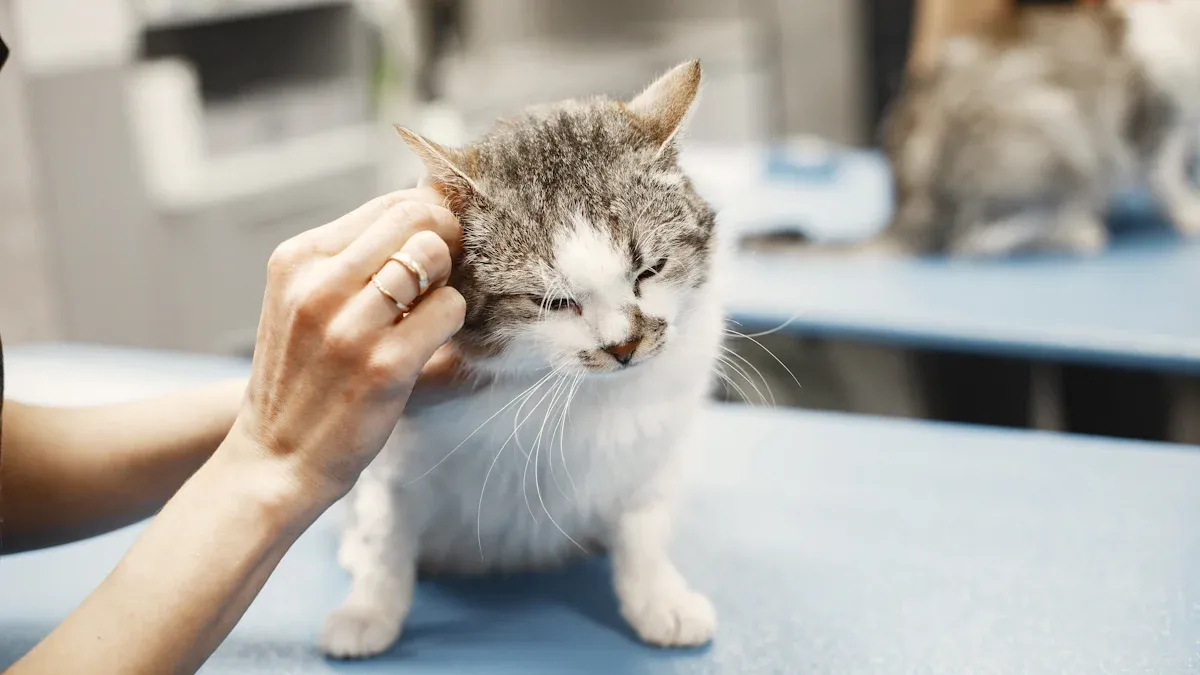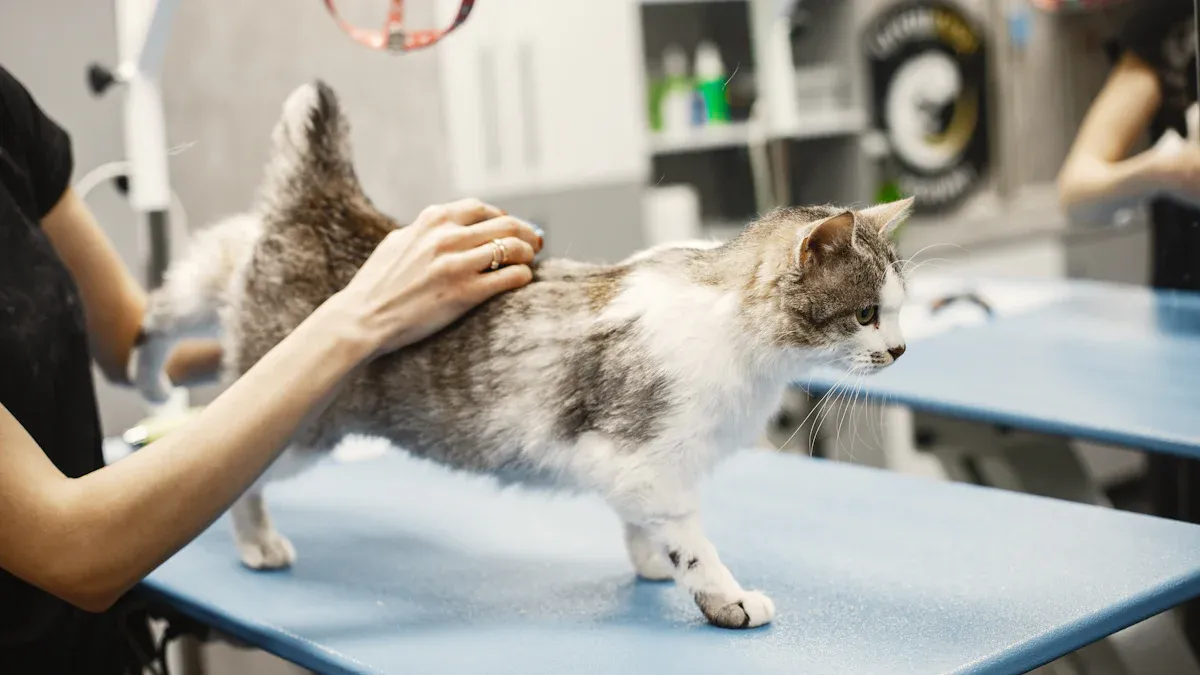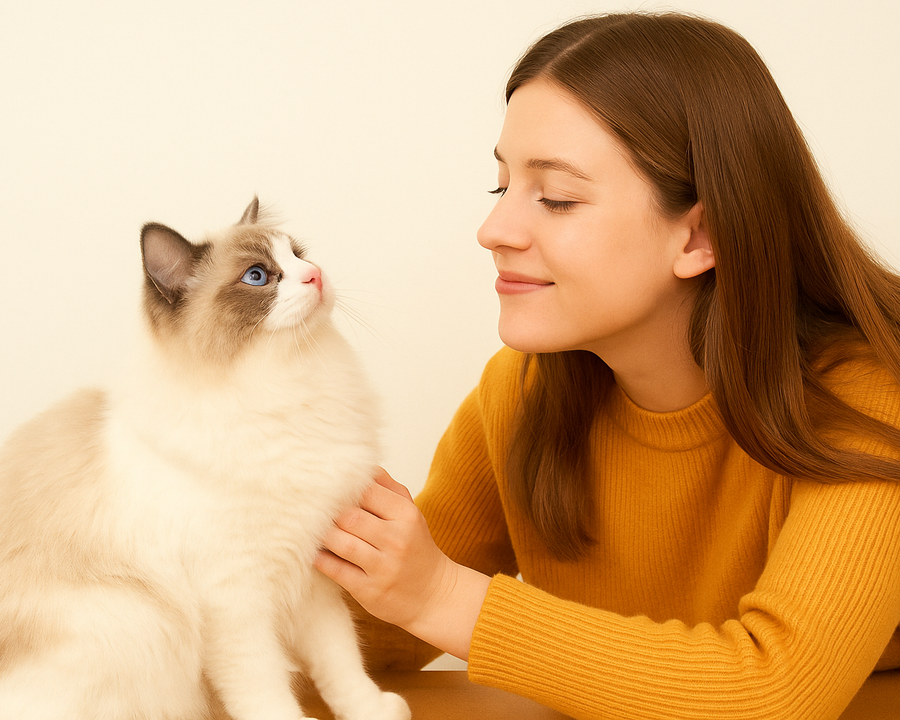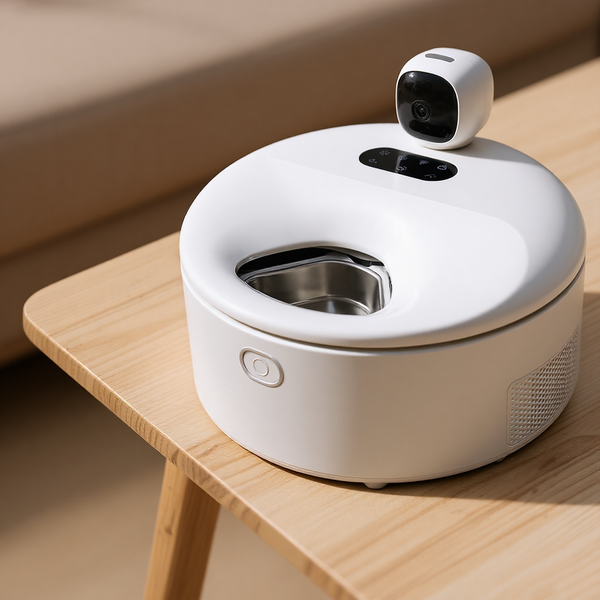
You want your cat to look great and feel comfortable, right? Experts say using the best cat brush does more than keep fur neat. Brushing helps remove dead hair, aerates the skin, and untangles knots that bother your cat. You can spot lumps or bumps early while brushing, which keeps your cat healthy. Regular grooming also boosts circulation and lets you spend quality time with your furry friend. Try brushing today and see your cat’s coat become shinier and softer.
Key Takeaways
-
Regular brushing keeps your cat's coat healthy and shiny. It removes loose hair, dirt, and prevents painful mats.
-
Choose the right brush based on your cat's fur type. Slicker brushes work well for long hair, while bristle brushes suit short hair.
-
Brushing strengthens the bond between you and your cat. It provides comfort and helps you check for health issues.
-
Use grooming tools like deshedding tools and grooming gloves to manage shedding and make brushing enjoyable.
-
Establish a brushing routine. Brush your cat weekly or daily, depending on their coat length, to maintain a clean and healthy coat.
Top 10 Best Cat Brushes
If you want your cat’s coat to look nice, picking the best cat brush is important. Experts have tried many brushes. They check how much hair each brush removes. They also see if the brush is easy to use. Some brushes work better for mats. Let’s see which brushes are the top choices for your cat.
Slicker Brush
Slicker brushes are popular with cat owners and groomers. They help get rid of loose hair and tangles. The Hertzko Self-Cleaning Slicker Brush and Safari Self-Cleaning Slicker Brush are easy to clean. You just press a button to clean them. These brushes have short wires close together. They move through your cat’s fur and pick up dead hair. You can use slicker brushes on cats with short or long hair. They are gentle, but don’t press too hard.
Tip: Experts like slicker brushes because they handle mats and shed fur well. They are easy to clean and comfortable for your cat.
Bristle Brush
A bristle brush is good for cats with short hair. The Mars Coat King Boar Bristle Cat Hair Brush is a top pick. Bristle brushes have soft fibers. They smooth the coat and remove loose fur. Brush in the same direction as the hair grows. This helps avoid skin problems.
|
Feature |
Description |
|---|---|
|
Benefits |
Gentle bristles work well for short-haired cats. They remove loose fur and keep the coat smooth. |
|
Usage |
Brush in the direction of hair growth. This keeps the coat sleek and avoids skin irritation. |
Pin Brush
Pin brushes are best for cats with medium or long hair. The Hartz Groomer's Best Combo Brush has both pin and bristle sides. Pin brushes have round tips. They untangle knots without hurting the skin. You can use them every day to keep fur soft and shiny.
|
Coat Type |
Brush Type Used |
Effectiveness Description |
|---|---|---|
|
Long-haired cats |
Good for detangling mats and making fur shiny and soft. |
|
|
All coat types |
Pin brushes |
Works well on knots; use as needed for your cat’s coat. |
Deshedding Tool
If your cat sheds a lot, try a deshedding tool. The FURminator is a favorite. It can lower shedding by up to 90% if you use it often. Undercoat rakes and slicker brushes also help with shedding. These tools reach deep and pull out loose hair before it gets on your furniture.
-
The FURminator can lower shedding by up to 90% with regular use.
-
Undercoat rakes and slicker brushes help control shedding and keep the coat healthy.
Grooming Glove
Grooming gloves make brushing fun for you and your cat. Put the glove on and pet your cat. HandsOn pet grooming gloves are very comfortable and easy to use. You can add a little water to pick up loose hair. This helps in hard-to-reach places. Grooming gloves are best for loose fur, but not for mats.
|
Feature |
Description |
|---|---|
|
Product Name |
HandsOn pet grooming gloves |
|
Recommendation Level |
Very popular for grooming cats |
|
User Satisfaction |
Comfortable and easy to use |
|
Additional Tips |
Use water to help pick up loose hair and reach tricky spots |
|
Not Suitable For |
Not good for removing matted fur |
Double-Sided Brush
Double-sided brushes give you two choices in one brush. One side has metal bristles for tangles. The other side has soft bristles for smoothing and shining. The Hartz Groomer's Best Combo Brush is a great example. Groomers like these brushes because they spread natural oils and help the coat stay healthy.
|
Benefit |
Description |
|---|---|
|
Detangling and Smoothing |
Takes care of tangles and leaves the coat smooth. |
|
Promotes Coat Health |
Spreads natural oils to make the coat healthy and shiny. |
|
Comfortable Grooming Experience |
Has a non-slip handle and breathing holes for easy grooming. |
|
Dual Functionality |
Metal bristles remove loose hair and massage the skin. |
|
Smooths and Shines |
Soft bristles make the coat look shiny and healthy. |
|
Regular Brushing |
Removes knots and keeps the coat clean and healthy. |
|
Health Monitoring |
Helps you spot fleas, ticks, and skin problems hidden by tangled fur. |
Rubber Brush
Rubber brushes are great for cats that are sensitive. They are easy to hold and gentle on the skin. The soft rubber bristles massage the skin and pick up loose fur. Many vets suggest rubber brushes for cats who don’t like regular brushes.
-
Rubber brushes are best for sensitive cats and give a gentle grooming experience.
-
They fit well in your hand and are easy to use.
-
The soft rubber bristles massage the skin and collect loose fur.
Long-Hair Comb
Long-haired cats need special tools to stop tangles and mats. Two-in-One Rake and Dual-Length Metal Comb are top choices. These combs remove mats and tangles. Their design makes grooming easy for you and your cat. If your cat does not like brushing, try a self-cleaning slicker brush with bristles that pull back.
|
Product Name |
Description |
|---|---|
|
Two-in-One Rake |
Removes tangles and mats; great for long-haired cats. |
|
Dual-Length Metal Comb |
Untangles and combs; used by groomers; comfortable to hold. |
|
Self Cleaning Slicker Brush |
Easy to use and clean; bristles pull back to prevent damage; good for cats who dislike brushing. |
Flea Comb
Flea combs help you check for fleas or flea dirt. These combs have fine teeth that pick up things from the coat. You can use them to find flea dirt, eggs, and fleas. Flea combing does not hurt your cat and helps you see if treatment is working.
-
Flea combs pick up things from the coat for checking.
-
They help you find flea dirt, which means fleas are present.
-
Flea combing is a gentle way to find fleas, eggs, and flea dirt.
-
The fine teeth catch even small signs of fleas.
-
Flea combing is a good way to control fleas in pets.
Self-Cleaning Brush
Self-cleaning brushes make grooming simple. Press a button and the bristles pull back. You can remove hair fast. Experts like features such as easy grip and reusable materials. The aumuca Self Cleaning Slicker Brush and Hertzko Self-Cleaning Slicker Brush are popular. These brushes save time and keep your cat’s coat tidy.
|
Feature |
Description |
|---|---|
|
Self-cleaning |
Some pet hair removers have a self-cleaning feature for easy use. |
|
Ergonomic design |
Tools are made for comfort and less strain. |
|
Reusable materials |
You can clean and reuse these tools, which is better for the environment. |
Note: Experts test brushes for hair removal, ease of use, and dematting. They look for safety, comfort, and easy cleaning. Bristle length and material are important. Pick a brush that matches your cat’s fur.
Sidebar Suggestion:
Want more ways to care for your pet? The Petcantalk Polar Smart Wet Food Feeder makes feeding easy and fun. It has a cool look and one-click serving. You can keep your cat happy and healthy. Over 1,000 pet owners trust Petcantalk for smart pet care. Free shipping on orders over $130!
Why Brushing Matters
Reduces Shedding
You probably notice cat hair on your clothes and furniture. Brushing helps you manage shedding before it gets out of control. When you brush your cat, you remove loose hair that would otherwise fall off naturally. This keeps your home cleaner and helps your cat feel comfortable. Regular brushing also improves skin health by boosting circulation and spreading natural oils through the coat. If you use the best cat brush, you can make shedding less of a problem.
-
Brushing removes loose hair before it sheds.
-
Regular grooming is one of the most effective ways to control shedding.
Prevents Mats
Mats can make your cat’s fur look messy and even cause pain. You can stop mats from forming by brushing your cat often. Long-haired cats need daily grooming to keep their fur tangle-free. Short-haired cats also benefit from regular brushing. When you use the right tools, you avoid painful mats and keep your cat’s coat smooth.
-
Daily brushing keeps fur tangle-free and removes loose hair.
-
Using the right brush for your cat’s coat type helps prevent mats.
-
Regular grooming routines are important for all cats.
Improves Coat Health
Brushing does more than make your cat look good. It helps your cat stay healthy. When you brush, you remove dirt, grease, and dead hair. This keeps the coat clean and shiny. Brushing also stimulates blood flow and removes dandruff or skin flakes. Your cat swallows less hair during self-grooming, so hairballs become less of a problem.
-
It removes dirt, grease, and dead hair.
-
It boosts blood circulation and removes dandruff.
Strengthens Bond
Grooming time is special for you and your cat. When you brush your cat, you build trust and make your cat feel safe. Many cats relax during grooming and enjoy the attention. You get to check for lumps, fleas, or ticks while spending quality time together. Shared grooming experiences help you and your cat feel closer.
-
It helps both of you relax and feel less stressed.
-
Close interactions during brushing deepen your bond.
Choosing the Best Cat Brush
Hair Type Considerations
You want your cat to look and feel great. Start by thinking about your cat’s fur. Cats have different types of coats. Some have long hair, some have short hair, and some even have curly hair. Each type needs a special kind of brush.
-
Size of the brush
-
Extra features for comfort
Long-haired cats need brushes that can handle tangles. Short-haired cats need less grooming, but a gentle brush keeps their coat shiny. Curly-haired cats do best with gloves that protect their curls. If your cat dislikes regular brushes, try a mitt brush. Understanding your cat’s fur helps you pick the right tool.
Here are some expert suggestions for matching brush types to fur:
-
Slicker brush for medium or long fur
-
Dual-sided brush for short to medium fur
-
Mitt brush for cats that dislike traditional brushes
-
Bristle brush for all cats
-
Dematting comb for long-coated cats
-
Shedding comb for all lengths
Key Features
When you shop for a brush, look for features that make grooming easy and safe. You want a brush that feels good in your hand and does not hurt your cat.
Professional groomers say you should use soft bristle brushes to avoid skin irritation. Rounded tines on combs help prevent injury. The right brush depends on your cat’s coat condition, length, and density.
Check for these features:
|
Feature |
Why It Matters |
|---|---|
|
Soft bristles |
Gentle on skin, less irritation |
|
Rounded tips |
Prevents scratching or injury |
|
Easy grip handle |
Makes brushing comfortable for you |
|
Self-cleaning |
Saves time and keeps brush hygienic |
Matching Needs
You want to match the brush to your cat’s grooming needs. Think about how often you need to brush and what your cat likes.
-
Short-haired Cats: Use a bristle brush to spread natural oils and keep the coat shiny.
-
Long-haired Cats: Use a slicker brush to remove tangles and loose fur.
-
Curly-haired Cats: Try grooming gloves to gently remove loose hair and keep curls neat.
If you want the best cat brush, choose one that fits your cat’s fur type and your grooming routine. Your cat will look better and feel happier.
Grooming Tips

Introducing Brushing
Getting your cat used to brushing can feel tricky at first. You want your cat to feel safe and happy. Try these steps to make grooming a positive experience:
-
Show your cat the brush and let them sniff it. Give a treat right after.
-
Let your cat rub against the brush or gently touch it to their head. Reward them again.
-
Start with short strokes on the head or cheek. Keep sessions brief and calm.
-
Praise your cat often and offer treats during grooming.
-
If your cat seems uncomfortable, slow down and go back to the last step they liked.
-
Always brush in the direction the hair grows. Never force your cat to be brushed.
You help your cat build trust with the brush when you move slowly and reward good behavior. Short, happy sessions work best.
Techniques by Coat Type
Different cats need different brushing routines. You want to match your technique to your cat’s fur. Here’s a quick guide:
|
Coat Length |
Recommended Frequency |
|---|---|
|
Short-Haired Cats |
|
|
Medium-Length Cats |
Weekly brushing |
|
Long-Haired Cats |
Daily brushing and combing |
For short-haired cats, use gentle strokes to remove loose fur. Medium-haired cats need a bit more attention to prevent tangles. Long-haired cats need daily care to stop mats from forming. Always check for knots and gently comb them out before they get worse.
Brush Care
You want your brush to last and stay clean. After each grooming session, remove hair from the bristles. Wash the brush with mild soap and water every few weeks. Let it dry before using it again. Clean brushes keep your cat’s coat healthy and free from dirt. Regular cleaning also helps you spot when it’s time to replace your grooming tool.
Tip: Set a reminder for brushing days. This helps you keep up with your cat’s grooming needs and makes the routine easier for both of you.
You want your cat to feel happy and look great. Regular brushing prevents matting, spreads natural oils, and keeps shedding under control. Check out the table below to see how brushing helps your cat:
|
What Brushing Does |
Health Boost |
Comfort Boost |
|---|---|---|
|
Stops painful mats |
Yes |
Yes |
|
Makes fur soft and shiny |
Yes |
Yes |
|
Reduces hairballs |
Yes |
Yes |
Pick a brush that fits your cat’s coat. Try expert-recommended tools and see the difference. You can also explore other pet care solutions like silicone brushes or smart feeders for a happier, healthier pet.
FAQ
How often should you brush your cat?
You should brush your cat at least once a week. Long-haired cats need daily brushing. Regular grooming keeps fur smooth and helps prevent mats.
What brush works best for kittens?
Soft bristle brushes or grooming gloves work best for kittens. These tools feel gentle on their skin and help them get used to grooming.
Can brushing help with shedding?
Yes! Brushing removes loose hair before it falls off. You keep your home cleaner and your cat feels more comfortable.
What if your cat hates brushing?
Try short sessions and use treats. Start with gentle strokes. You can use a grooming glove if your cat dislikes regular brushes.
Do you need different brushes for long and short hair cats?
Yes. Long-haired cats need slicker brushes or combs for tangles. Short-haired cats do well with bristle brushes or grooming gloves.




